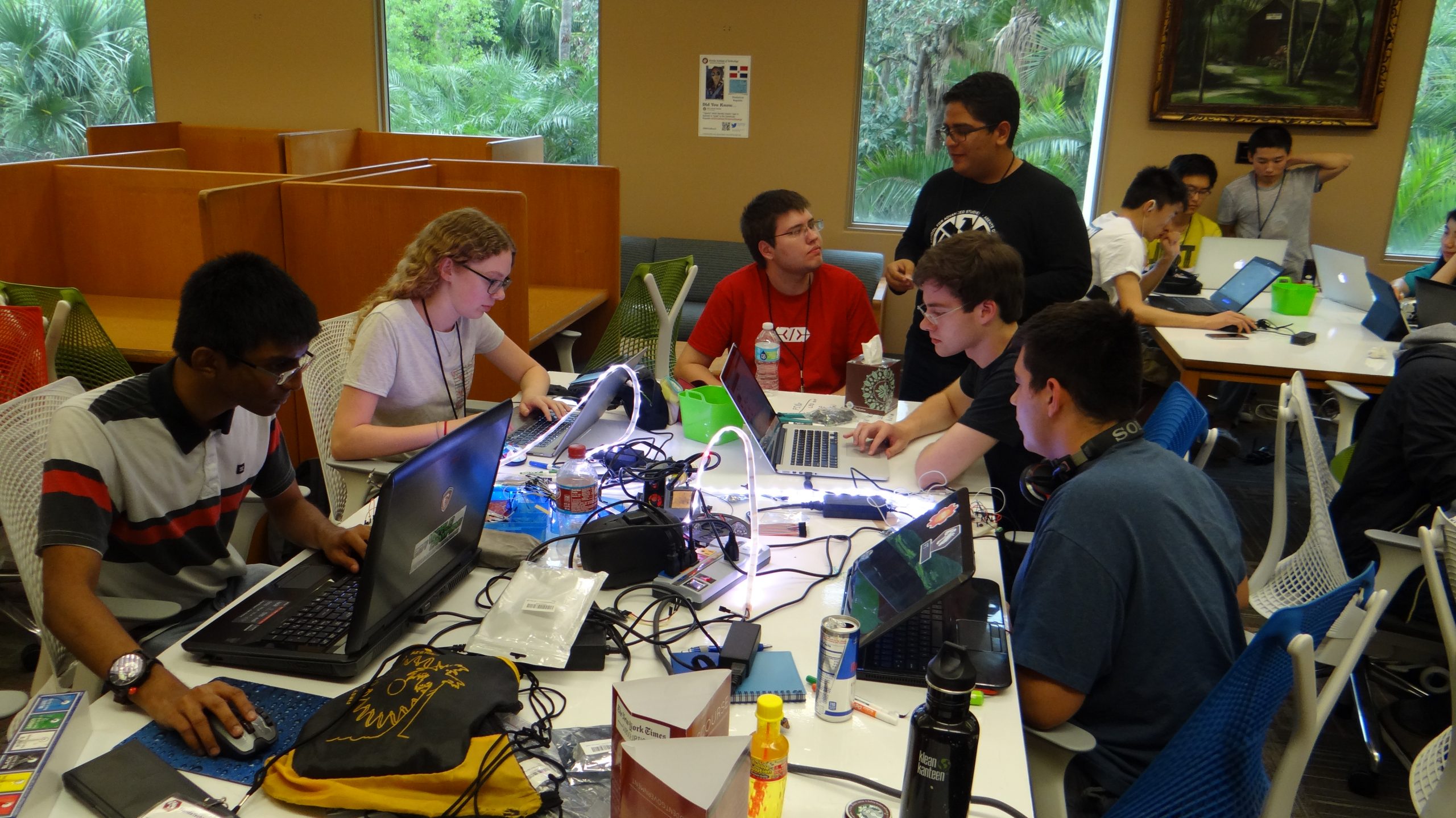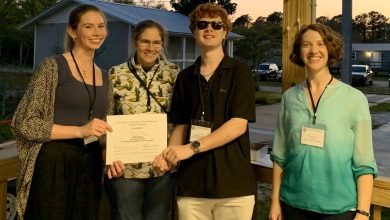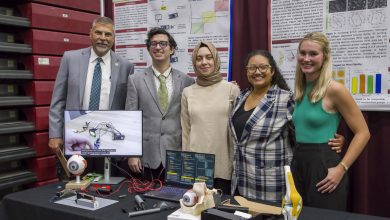Engineering an Entrepreneurial Ecosystem: Providing An Environment To Inspire Students From Conceptualization To Commercialization
By Rolanda Hatcher-Gallop
The gleam in Christopher Kennedy’s eyes says it all. “Getting to launch two rockets in one day? It doesn’t get any better than this for me. I’m beyond excited,” said Kennedy, a senior aerospace engineering student.
One of those rockets is his team’s senior capstone design project, a small, solid fiberglass construction named “Hydra” as homage to the Captain America comic books and movies. But while the name is steeped in fiction, the rocket’s purpose is very real.
“The main thing we’re testing is a hypersonic inlet that is embedded in the nose cone. We’re collecting pressure and temperature data inside the inlet to relate a lower-speed, lower-altitude flow to one that is usually higher up and faster,” explained Kennedy, who serves as the lead rocket specialist on the project and aspires to have a career flight testing newly developed aircraft and spacecraft.
The project could signal a reduction in the overall cost of hypersonic flight testing.
“This allows us to expand the possibility of hypersonic flight testing down to the university level, which opens up the door to a greater audience. The entrepreneurial potential is great,” Kennedy said.
Thinking about marketplace opportunities and enduser applications of design concepts and inventions are becoming the norm for an increasing number of Florida Tech students like Kennedy, thanks to significant partnerships in the College of Engineering and Nathan M. Bisk College of Business and recent campus additions intended to foster an entrepreneurial mindset.
“It’s really an exciting time to be on campus,” Kennedy said. “You can see your idea go from concept to design to prototype, and prototype can lead to entrepreneurship.”
Sure, Florida Tech has transformed itself into a world-class research center over the last decade with such additions as the Harris Center for Science and Engineering and The Scott Center for Autism Treatment. But the university has also built a solid reputation as a champion of entrepreneurship, helping to foster generations of business owners and founders over the university’s 60-year history—an accomplishment that landed Florida Tech on Forbes magazine’s list of the nation’s 50 most entrepreneurial research universities last year for the second consecutive time.
In recent years, the university has rolled out new strategies encouraging students to engage in learning opportunities designed to ignite creativity and innovation as well as to provide business skills necessary for them to blaze their own paths.
This thrust toward expanding engineering education to include an entrepreneurial focus is evident in the new programs, partnerships and facilities that have come to life within the last year. These include:
The Harris Student Design Center, an 11,500-square-foot structure made possible by a $1 million gift from Harris Corp., located on the south side of the main campus. The center, which opened in November, serves engineering and science students completing capstone design projects;
The Center for Advanced Manufacturing and Innovative Design (CAMID) located in Florida Tech’s Research and Development Center on Palm Bay Road. The center, which opened in January, provides general advanced manufacturing training along with labs, training and design tools and methods specifically for aeronautics, aerospace engineering and the space industry;
The Digital Scholarship Lab (DSL) on the second floor of Evans Library, which officially opened in January, supports research, teaching and learning in all Florida Tech disciplines through the use of hands-on digital tools and applications;
The Larsen Motorsports High Performance Vehicles Research & Development Center, a 30,000-square-foot space in the university’s Research and Development Center that opened in February. Backed by the university’s affiliation with the award-winning racing organization, the facility features full-concept design, engineering and fabrication capabilities where students get to fabricate everything from afterburners to chassis components and to learn about the day-to-day operations of the company’s jet-powered dragsters; and
The Kern Entrepreneurial Engineering Network (KEEN) Innovative Challenges, a series of weekly engineering design competitions that kicked off in late January. The challenges, patterned after similar competitions at St. Louis University, are fueled by a grant from the Kern Family Foundation.
These initiatives join other programs and facilities that are already thriving on campus, including the Nathan M. Bisk College of Business’ Momentum Student Business Incubator, which launched in late 2012 to assist students in creating their own businesses while earning their Florida Tech education.
Collectively, they are all a part of an emerging entrepreneurial ecosystem on campus.
Dean of Libraries Sohair Wastawy said this system of resources is necessary in order to meet the needs of those preparing to enter the 21st-century global marketplace.
“It is all about providing our students with the tools needed to engage technology in novel and new ways to get ideas across, while also nurturing entrepreneurial thinking,” she said.
For instance, the DSL was born from Evans Library recognizing that student and faculty researchers needed digital tools and resources such as data curation, digitization, spatial analysis and visualization to enable them to access, integrate and share current and future research.
“Building the DSL was our response to the new forms of scholarship and FIT’s cross-disciplinary collaboration for breakthrough innovation,” Wastawy explained.
Fostering creative freedom
With a vibrant, open workspace for creating and nurturing ideas, the DSL offers students technological tools that include graphics intensive applications, interactive computing, Geographic Information Systems (GIS), large-scale multi-touch displays, virtual reality, 3-D printing and scanning, and textual analysis.
More than 12,000 people have visited the lab since its soft opening in November, a couple of months before it formally opened in January.
Natalie Shah is one of them.
“The first time I went into the DSL, I sat on one of the cone-shaped chairs and just spun around. It was the day after it officially opened, and there was so much to take in,” said Shah, a sophomore majoring in biomedical engineering.
“It definitely fits the needs of students, with everything from whiteboards and Mac computers to the touchscreen SMART board. The whole place is bright, open and inviting. It’s a great area where you can go and study,” she said.
Senior Milton Stafford said the facility gives students creative freedom, with a layout that is “almost like you’re in this Google brainstorming room.”
Stafford, a computer science major, participated in Florida Tech’s first hackathon, FloridaTechHacks, which was held in the DSL in early April and sponsored by the KEEN grant. He was among 142 participants from six Florida universities who came together to create and complete 32 projects within 24 hours.
Nancy Garmer, interim assistant dean in user experience and learning in Evans Library, said the event was successful in bringing students together to network and strengthen their team-building skills.
“Students worked in multiethnic and gender-mixed teams of four persons or less to create projects that they presented to judges, with prizes awarded to the most innovative and implementable designs,” she said.
First place was awarded to a team who created an app to scan food ingredient lists on packaging to determine if a consumer is allergic to any of the ingredients.
“The entire event really was so much fun, it was so great to see all of the students with their energy and ideas,” Garmer said.
Stafford said he went into the event expecting it to be an intense coding session. Instead, he found it to be so much more than that.
“The hackathon enabled us, as students, to go from creating an idea to actually developing ways to advertise and sell that idea,” he said.
Stafford and his team came up with the concept of building an FIT digital storefront that would allow students to buy and sell from each other in an easy-to-use, online and mobile-friendly marketplace directly connecting buyers and sellers, similar to Craigslist.
“For about nine hours, we spent time developing the implementation of this idea. It was different for me in the sense that I was doing something I’d never done before, which was to create a no-sequel database backend for the application,” he said.
“The mindset was different in that I also was looking at potential consumers for this idea. The thought of having a demographic—clients to work with on a longterm basis— changed my perspective,” he said.
Before participating in the hackathon, Stafford admitted that the extent of his entrepreneurship was to sell his own skills as an employee.
“This event gave me the perspective of selling the things that I produce, not just myself as a producer,” he said. “I think it turned into a much more well-rounded experience for me and everyone else.”
Major League Hacking, an organization that supports over 200 weekend-long student invention competitions annually around the world, certified this year’s hackathon.
“We’re already gearing up to host another one next year,” Garmer said.
Thinking past the product Hunter Lee, a mechanical engineering sophomore, said he would consider participating in next year’s hackathon. However, one of his main interests on campus this semester was the KEEN Innovation Challenges.
“I participated in three challenges and had a lot of fun in each one,” Lee said. “I can’t wait to do it again.”
The event features teams of three students (with at least one engineering major) given challenges requiring them to communicate, organize and plan their solutions within a one-hour timeframe. Prizes are awarded to select teams at the end of each challenge.
“Each experience was different because you never knew what task you’d get,” Lee said.
“For instance, my first challenge had my team building a chair for a character on “The Simpsons” for a specific situation. Another one was coming up with a whole presentation on why being an engineer is awesome.
“No matter what the challenge, each team had to think on their feet and come up with either a prototypeor presentation in less than an hour,” he said.
Lee said the best part of the experience was having the opportunity to brainstorm and work with other engineering students to come up with cool ideas.
“It totally challenges your brain and team-building abilities,” Lee said.
And that is what the experience is designed to do, said Beshoy Morkos, an assistant professor in the department of mechanical and aerospace engineering. Morkos is one of the co-principal investigators of a $276,000 grant given to FIT by the Kern Family Foundation to partner with the Kern Entrepreneurial Network (KEEN) of colleges and universities to develop and implement strategies that promote the entrepreneurial mindset.
Along with Chiradeep Sen and Daniel Kirk in the College of Engineering, and Abram Walton from the Nathan M. Bisk College of Business, Morkos leads a team of 18 faculty members and 90 students charged with creating curricular and extracurricular activities on campus for this purpose.
“Our goal is to try to get students to think differently, to think past what they are producing and look at the bigger picture,” Morkos said.
He said the innovation challenges provide the perfect environment for that.
“When you put a bunch of engineers in a room and tell them to design a solution to a problem, they start thinking about how to approach it. But then, they also start looking around the room and begin to realize there are 10 other people thinking along the same wavelength.
“Because these challenges are competitive, it dawns on them that they really can’t just get away with having a good engineering solution, there has to be added value. There has to be more to it, something different,” Morkos explained.
“These challenges force students to think past the product. That kind of thinking is instrumental in the entrepreneurial mindset we want them to have,” he added.
The challenges, which drew up to 60 students per session this spring, are slated to resume in the fall.
Lee, who wants a career designing and testing new automotive products, said the innovation challenges gave him the opportunity to meet more engineering professors as well as to connect with other students with similar aspirations.
“We were all in there together, in our teams sharing ideas and finding solutions in innovative ways. It felt good to exercise my brain in a different way,” Lee said. “I felt like I was stretching my boundaries, and I’m ready for more.”





